|
 Entoloma haastii Entoloma haastii
SynonymsRhodophyllus haastii
Entoloma nitidum
BiostatusPresent in region - Indigenous. Non endemic
Images (click to enlarge)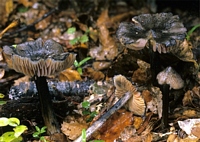
Caption: identity uncertain
Owner: G.L. Barron | 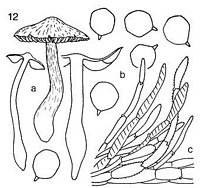
Caption: Entoloma haastii Stev. (Herb.
Hk. 69/174): a. carpophores. b. spores. c. cuticle. | 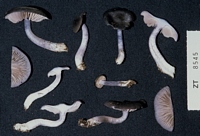
Caption: ZT8545: pdd71308: Entoloma haastii
Owner: Egon Horak | 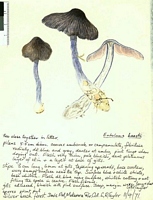
Caption: Watercolour
Owner: G.M. Taylor | 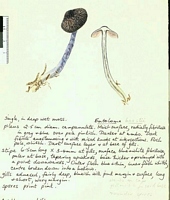
Caption: Watercolour
Owner: G.M. Taylor | 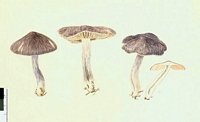
Caption: Watercolour
Owner: G.M. Taylor | 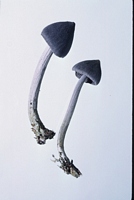
Owner: Herb. PDD | 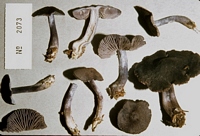
Caption: ZT2073: Entoloma haastii
Owner: Egon Horak | 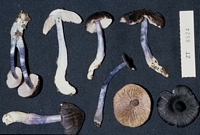
Caption: ZT8524: Entoloma hasstii
Owner: Egon Horak | 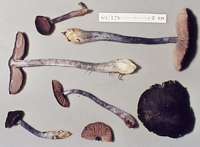
Caption: 69/174: pdd 27020: Rhodophyllum haastii
Owner: Egon Horak | 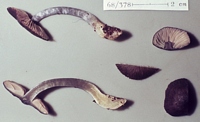
Caption: 68/378: pdd 88683: Rhodophyllum haastii
Owner: Egon Horak |
Article: Horak, E. (1973). Fungi Agaricini Novazelandiae I-V. Beihefte zur Nova Hedwigia 43: 200 p.
Description: Pileus
15-55 mm diam., conical later becoming distinctly umbonate, gibbous or campanulate,
in aged carpophores margin also upturned, dark brown or soot-brown but always
showing a more or less blue tinge, dry, covered by radially arranged wrinkles
or veins, neither striate nor hygrophanous. Lamellae (L 16-22, l 3(-7), adnexed
to subfree, grey-bluish becoming pink, gill edge straight or subserrate, concolorous.
Stipe 40-100 x 3-10 mm, fusoid, bulbous-rooting or clavate, apically deep blue
fading towards the whitish or ochraceous base, strongly fibrillose, dry, hollow,
fragile, often twisted. Context blue in pileus and upper parts of stipe, whitish
or yellowish at the base. Taste and odor strongly acidulous.
Spores
7-9 x 6.5-8 µm, subglobose, with 5-7 blunt angles. Basidia 30-35 x 10 µm, 4-spored.
Cheilo- and pleurocystidia none. Cuticle a trichoderm observed on not weathered
specimens, or a cutis with suberect to cylindrical hyphae (5-12 µm diam.), terminal
cells fusoid, membrane thin-walled, not gelatinized, with blue-brownish, plasmatic
pigment. Clamp connections present.
Habitat: On
soil among litter in forests (mainly under Nothofagus spp., rarely under
Leptospermum spp., Dacrydium or Podocarpus spp.). New Zealand.
Notes: This
species is quite common in the forests of New Zealand and its altitudinal range
is from the coast to the timber line.
As
Stevenson (1962: l.c.) already indicates E. haastii is closely related
to the European E. nitidum Quelet and E. madidum (Fr.) and resembles
also another undescribed species from the Patagonian forests in South America.
A thorough study of all members of this group is necessary to define these different
taxa clearly.
Article: Stevenson, G. (1962). The Agaricales of New Zealand: III. Kew Bulletin 16(2): 227–237.
Description: Pileus 3.5 cm. diam., sooty blue, broadly conical, moist, finely wrinkled; flesh thin, grey. Gills adnexed, moderately distant, greyish sky blue becoming stained pink. Stipe 4.5-6 x 0.3-1 cm., dark blue above, white below, with yellow tinge near bulbous base, silky-striate, hollow. Spores angled, subspherical, 8 x 10um; print pink; no cystidia.
Habitat: rooting in litter, Dun Mt., Nelson, 25.4.1949, Stevenson.
Notes: This fungus is fairly close to R. nitidus Quel. as described by Lange, but it is smaller with a less attenuated stipe, and has substantially larger spores.
|